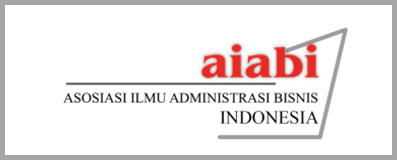Analysis of Learning and Growth, Business Processes, Costs and Service Innovation on Customer Loyalty with Customer Satisfaction as an Intervening Variable
DOI:
https://doi.org/10.31334/bijak.v19i2.2424Keywords:
Learning and Growth, Business process, Cost and Service Innovation, Customer loyalty, Customer satisfaction, Children's and Mother's HospitalAbstract
The aims of this study were to 1) analyze the effect of learning & growth, business processes, costs, service innovation on customer satisfaction at RSAB Harapan Kita partially or simultaneously; 2) analyze the effect of customer satisfaction on customer loyalty at RSAB Harapan Kita; and 3) knowing the effect of learning & growth, business processes, costs and service innovation on customer loyalty with customer satisfaction as an intervening variable at RSAB Harapan Kita. This study uses a quantitative approach with multiple linear regression analysis techniques. The population in this study was patients, which included outpatients at RSAB Harapan Kita in 2020. The sampling technique used was a non-probability sampling technique with an accidental sampling approach, so that 97 respondents were obtained. The data collection technique used a closed questionnaire with a measurement scale using a five-point Likert scale. The results of the study can be concluded that overall there is an effect of learning, business processes, costs and innovation (variable X) on loyalty (Y) through customer satisfaction (Z).References
L. S. Rionanda, F. Farida, F. G. Putra, E. Damayanti, and K. C. Pradana, “ICT-Based Lajur Bata Game Media Using Guided Discovery Method on Flat-sided Space Geometry Subject,†J. Corner Educ. Linguist. Lit., vol. 1, no. 4, pp. 235–248, 2022, doi: 10.54012/jcell.v1i4.47.
A. Widhiarso, “Telemedicine dan Telepharmacy : Tantangan dan Perkembangan Di Masa Pandemi Covid-19,†J. Farm. dan Kesehat. Indones., vol. 1, no. 1, pp. 46–54, 2021.
A. H. Fuchs, “Psychology and ‘The Babe,’†J. Hist. Behav. Sci., 34 153-165., 1998.
D. Dunlop and M. Zubkoff, “Inflation and Consumer Behavior in the HealthCare.In Economics and Health Care.,†(J. B. MCKinley, Ed.). MIT Press., 1981.
E. Hertz, Medical equipment management program standards-ANSI/AAMI EQ56 AND ANSI/AAMI EQ89, Second Edi. Elsevier Inc., 2019.
R. S. Kaplan and D. P. Norton, Using the balanced scorecard as a strategic management system. Harvard Bus. Rev. 150–161., 2007.
Carter and Usry, Cost Accounting, 13th ed. Jakarta: By South-Western, A Division of Thomson Learning Inc. (terjemahan). Akuntansi Biaya, Edisi Tiga Belas, Salemba Empat, Jakarta, 2006.
A. Azwar, Menjaga Mutu Pelayanan Kesehatan. Jakarta: Pustaka Sinar Harapan, 1996.
A. Adil, M. Syamsun, and M. Najib, “Pengaruh Kualitas Pelayanan dan Biaya terhadap Kepuasan dan Loyalitas Pasien RSUD Kota Bogor,†J. Apl. Manaj., vol. 14, no. 3, pp. 432–441, 2016.
P. Kotler and K. L. Keller, “Marketing Management (15th Edition) - Philip Kotler,†Fortune, p. 290, 2017.
Lu and Tseng, “The Effectiveness of Inquiry-Based Learning by Scaffolding Students to Ask ‘5 Why’ questions.,†Dep. Nat. Sci. Educ. Natl. Taipei Univ. Educ., 2010.
E. M. Rogers, Difussion of Innovations. London : Coller Macmillan Publisher., 1983.
C. R. Dwi Wahyuni, “Kualitas Pelayanan Dan Pengaruhnya Terhadap Loyalitas Pelanggan Yang Di Mediasi Oleh Kepuasan Di Bank Muamalat Jombang,†Eksis J. Ris. Ekon. dan Bisnis, vol. 12, no. 1, pp. 69–82, 2017, doi: 10.26533/eksis.v12i1.84.
B. R. Ananda, R. E. Putera, and R. Ariany, “Inovasi Pelayanan Kesehatan Di Rumah Sakit Umum Daerah Kota Pariaman,†Publik (Jurnal Ilmu Adm., vol. 8, no. 2, p. 167, 2020, doi: 10.31314/pjia.8.2.167-179.2019.
P. Thaichon, A. Lobo, and A. Mitsis, “Achieving customer loyalty through service excellence in internet industry,†Int. J. Qual. Serv. Sci., vol. 6, no. 4, pp. 274–289, 2014, doi: 10.1108/IJQSS-03-2014-0024.
F. Tjiptono, Strategi Pemasaran. Yogyakarta : Andi, 2015.
B. Tay and D. Sundiman, “Pengaruh Inovasi Hijau Terhadap Kinerja Berkelanjutan: Peran Moderasi Dari Kepedulian Lingkungan Manejerial (Studi Pada Umkm Di Batam),†DeReMa (Development Res. Manag. J. Manaj., vol. 16, no. 1, p. 96, 2021, doi: 10.19166/derema.v16i1.2505.
H. N. Soetjipto, Perspektif Pembelajaran Dan Pertumbuhan Dalam Implementasi Balance Scorecard Sebagai Instrumen Penilaian Kinerja. 2018.
E. Ahoa, A. Kassahun, and B. Tekinerdogan, “Business processes and information systems in the Ghana cocoa supply chain: A survey study,†NJAS - Wageningen J. Life Sci., vol. 92, no. March 2019, p. 100323, 2020, doi: 10.1016/j.njas.2020.100323.
S. Peters, Y. Kerner, R. Dijkman, I. Adan, and P. Grefen, “Fast and accurate quantitative business process analysis using feature complete queueing models,†Inf. Syst., vol. 104, p. 101892, 2022, doi: 10.1016/j.is.2021.101892.
D. D. Rahmawati, “Pengaruh Persepsi Harga Terhadap Kepuasan Konsumen Pengguna Jasa Travel,†Bongaya J. Res. Manag., vol. 3, no. 2, pp. 21–27, 2020, doi: 10.37888/bjrm.v3i2.239.
F. Manan, M. Nasir, and S. Saidin, “Strategi Inovasi Pelayanan Kesehatan Pada Rumah Sakit Umum Daerah Kota Kendari,†NeoRespublica J. Ilmu Pemerintah., vol. 1, no. 2, p. 119, 2020, doi: 10.52423/neores.v1i2.10427.
F. Tjiptono and G. Chandra, Service, quality and satisfaction. Yogyakarta: Andi, 2016.
P. T. Kotler, M. Brady, M. Goodman, and T. Hansen, Marketing Management. Pearson Education, 2019.
D. A. Fitriani, S. A. Pasinringi, I. Irwandy, and H. Amqam, “The effect of perceived value toward loyalty through patient satisfaction in Hasanuddin University Hospital,†Enferm. Clin., vol. 30, pp. 408–411, 2020, doi: 10.1016/j.enfcli.2019.11.008.
Downloads
Published
Issue
Section
License

This work is licensed under a Creative Commons Attribution-ShareAlike 4.0 International License
Please find the rights and licenses in Majalah Ilmiah Bijak By submitting the article/manuscript of the article, the author(s) agree with this policy. No specific document sign-off is required.
- License
The commercial use of the article will be governed by the Creative Commons Attribution license as currently displayed on Creative Commons Attribution-ShareAlike 4.0 International License.
2. Author(s)' Warranties
The author warrants that the article is original, written by stated author(s), has not been published before, contains no unlawful statements, does not infringe the rights of others, is subject to copyright that is vested exclusively in the author and free of any third party rights, and that any necessary written permissions to quote from other sources have been obtained by the author(s).
3. User Rights
Majalah Ilmiah Bijak spirit is to disseminate articles published are as free as possible. Under the Creative Commons license, Majalah Ilmiah Bijak permits users to copy, distribute, display, and perform the work for non-commercial purposes only. Users will also need to attribute authors and Majalah Ilmiah Bijak on distributing works in the journal and other media of publications.
4. Co-Authorship
If the article was jointly prepared by more than one author, any authors submitting the manuscript warrants that he/she has been authorized by all co-authors to be agreed on this copyright and license notice (agreement) on their behalf, and agrees to inform his/her co-authors of the terms of this policy. Jurnal Bijak will not be held liable for anything that may arise due to the author(s) internal dispute. Majalah Ilmiah Bijak will only communicate with the corresponding author.
5. Miscellaneous
Majalah Ilmiah Bijak will publish the article (or have it published) in the journal if the article’s editorial process is successfully completed. Jurnal Bijak editors may modify the article to a style of punctuation, spelling, capitalization, referencing and usage that deems appropriate. The author acknowledges that the article may be published so that it will be publicly accessible and such access will be free of charge for the readers as mentioned in point 3.
Every accepted manuscript should be accompanied by "Copyright Transfer Agreement"prior to the article publication.





1.png)




